Hybrid Selection – Plant Height and Grain Yield
This tip was provided by:
Ronnie Schnell, Cropping Systems – Statewide, College Station, ronschnell@tamu.edu
Statewide
Hybrid Selection – Plant Height and Grain Yield
In a previous tip, we discussed variation of flowering times by maturity group and production region and the impact maturity has on grain yield. When soil moisture is not limiting, later maturing hybrids generally produce greater yields. Will plant height affect grain yield? Plant height is generally a function of maturity and internode length. Various maturity genes control flowering and internode length is controlled by four dwarfing genes. In addition to increasing plant height, later maturity generally results in greater leaf number.
Grain sorghum performance trials conducted by the Soil and Crop Science Department across Texas routinely measure plant characteristics, including days to bloom, plant height, panicle exertion, etc. Plant height, measured from the ground to the tip of the panicle, is recorded for every plot each year in the statewide sorghum performance trials (about 1,600 plots per year). Average plant height for maturity groups and production regions are shown in figure 1.
For every production region in Texas, plant height is positively correlated with grain yield (Figure 2). Looking within maturity groups, taller plants generally yield better than shorter plants. Although, variation in plant height within maturity groups may reflect variation in maturity more so than variation in internode length. Given that taller plants yield better, are they more susceptible to lodging? For short stature grain sorghums evaluated in the statewide testing program, no correlation between plant height and lodging was observed during the last four years. Other factors such as stalk thickness (also affected by plant populations), stress tolerance and disease resistance may have greater influence on susceptibility to lodging. For more information on sorghum performance trials, visit: http://varietytesting.tamu.edu/grainsorghum/.
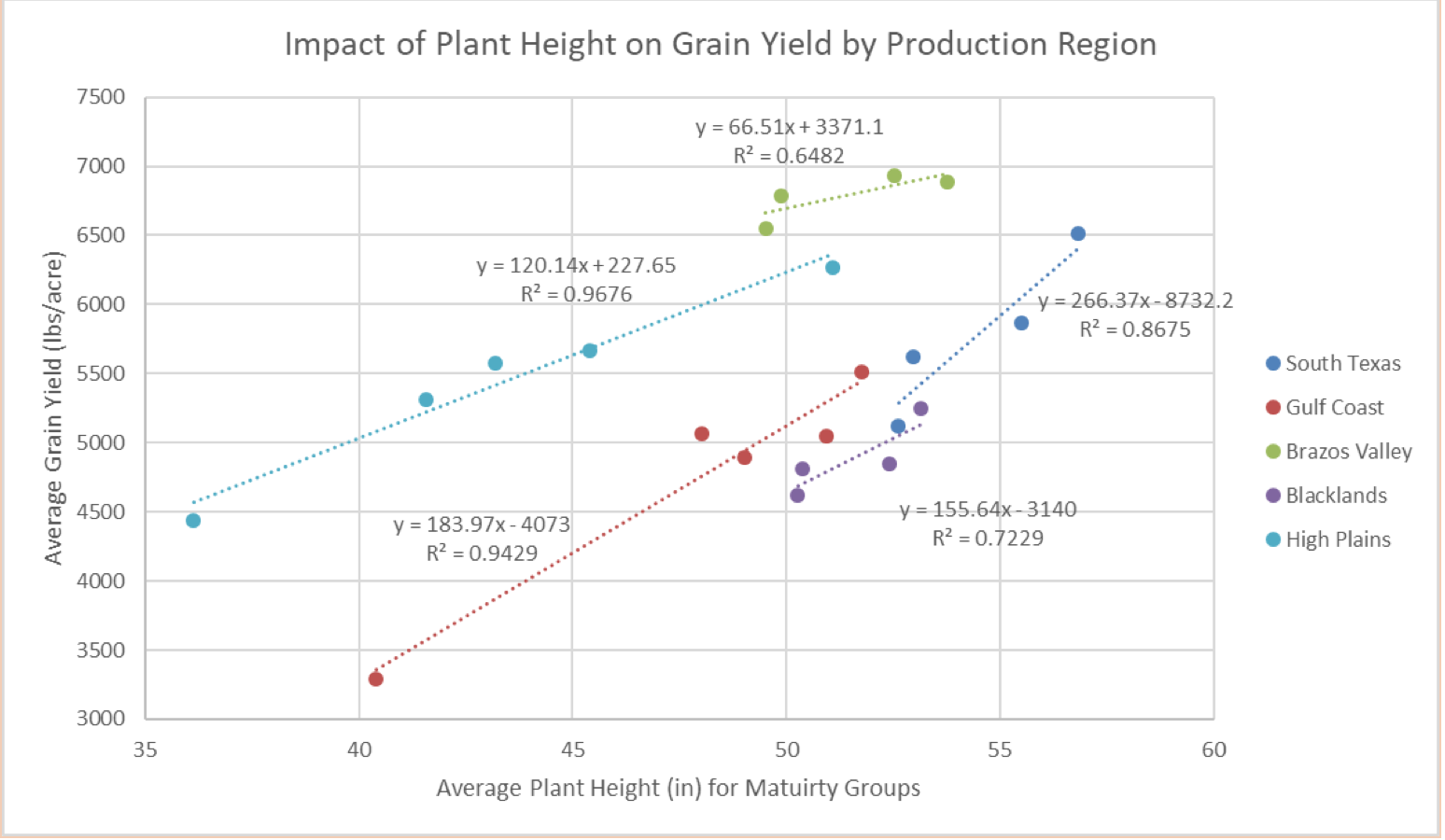
Figure 2. Impact of plant height (inches) on grain yield (lbs/acre) for production regions in Texas. Plant height is the average height for maturity groups (Early, Medium-Early, Medium, Medium-Late, Late) by region.
Sorghum Physiology & Management II
This tip was provided by:
Calvin Trostle, Extension Agronomy, Lubbock, 806-746-6101, ctrostle@ag.tamu.edu
Statewide
Sorghum Physiology & Management II
This is the second of a series of five Sorghum Tips AgriLife will share intermittently over fall and winter of 2017-2018. The first discussed rooting issues in grain sorghum, see http://texassorghum.org/sorghum-physiology-management-first-in-a-series.html
Physiology Driven Sorghum Management Consideration #2:
- Location of sorghum roots near the soil surface and N fertilizer application.
In Texas and other states using a knife or coulter rig to apply banded fertilizer, including nitrogen (N) after the plants are established is a convenient way to efficiently place nutrient in or near the root zone. The pluses are the specific placement, likely increased nutrient efficiency, and perhaps—due to this efficiency—reduced fertilizer cost. Disadvantages include the time it takes to fertilize a large number of acres vs. using a fertilizer spreader (which if the fertilizer remains on the soil surface is subject to volatilization losses and needs or irrigation to incorporate) or other broadcast method.
You do not want to prune roots in any significant fashion, however, as this could limit crop growth. It only takes a few minutes to determine where your roots are at. If you are knifing fertilizer in the middle of the rows, equidistant between the plants, this is not likely a significant concern though this puts the N or other fertilizer like P up to 20” away from the plant.
Using a shovel to dig a 8” deep cross-section of a plant’s root profile perpendicular to the planted row of sorghum. This will indicate where the roots are present near the soil surface. Farmers should ensure that no more than a minimal amount of the grain sorghum root system is severed. If this may occur, then sidedress N applications need to be made further from the row. Checking to see the location of the root system is also helpful as the same hybrid planted in the same soil type but in a different year may have a somewhat different rooting pattern, particularly in wet vs. dry years.
I will discuss in the next Sorghum Tip a major growth and development stage (growing point differentiation). Due to the importance of that stage of growth it is preferable that side-dress N applications or any other fertilizer applications need to be applied by a certain stage of growth, which may be earlier than some farmers realize. For this reason, waiting to apply sidedress N when sorghum is taller (say 18-24”) can have reduced benefit. The later applications also are more likely to be the maximum distance from the plant (middle of row). An earlier application closer to the row will position the sorghum plant to “grow into the fertilizer band.” That is good for efficient nutrient uptake.
Sorghum Physiology & Management (first in a series)
This tip was provided by:
Calvin Trostle, Extension Agronomy, Lubbock, 806-746-6101, ctrostle@ag.tamu.edu
Statewide
Sorghum Physiology & Management (first in a series)
This is the first of a series of five Sorghum Tips AgriLife will share intermittently over fall and winter of 2017-2018.
Physiology of sorghum plants is described in detail in numerous publications, but in particular Kansas State’s Dr. Richard Vanderlip first wrote “How a Sorghum Plant Develops” in the 1970s. It was revised in 1993 (see https://www.bookstore.ksre.ksu.edu/pubs/S3.pdf). There are several practical considerations for a farmer, a crop consultant, agronomist, or educator to understand about how sorghum grows and how management may enhance or hinder sorghum productivity.
Physiology Driven Sorghum Management Consideration #1:
- Sorghum planting pattern may affect later brace root development and standability pending sorghum planting in a furrow, on flat ground, or on an elevated bed.
Row-crop sorghum is planted in a range of planting patterns from furrow planting to flat to planting on an elevated bed. Due to the increase of reduced tillage and no-till systems grain sorghum is more likely planted on flat ground than in the past. The drier conditions become, the more likely that sometimes brace roots have trouble penetrating dry or hard soil at the base of the plant. In contrast much sorghum historically has been planted at a slightly depressed location—a small furrow—relative to the surrounding soil. In some cases, in semi-arid regions sorghum may still be planted ‘in the hole,’ a furrow that may be 4-8” deep, which enhances potential access to moisture. In this situation (and also for flat-planted sorghum) when mechanical cultivation was still widely used, it was common for the cultivation to throw soil around the base of the sorghum plant once the plants were about 15” or taller. This practice buried small weeds in the row and placed the lower nodes (up to node 9), which produce brace roots, in the soil (Figs. 1A&B). Sorghum managed in this fashion is less likely to lodge.
In contrast western and southern areas of the U.S. grain sorghum belt where sorghum is grown in semi-arid dryland conditions and wind erosion is a major concern. Row crop fields—especially for cotton—are listed in ‘beds’ that leave a furrow of 4-10” deep (Fig. 2). At cotton planting the top of the bed is knocked off to plant the seed in moist soil that is still warmer than soil temperatures in flat ground. This practice, however, is extended to grain sorghum often to the detriment of root development and sorghum standability.
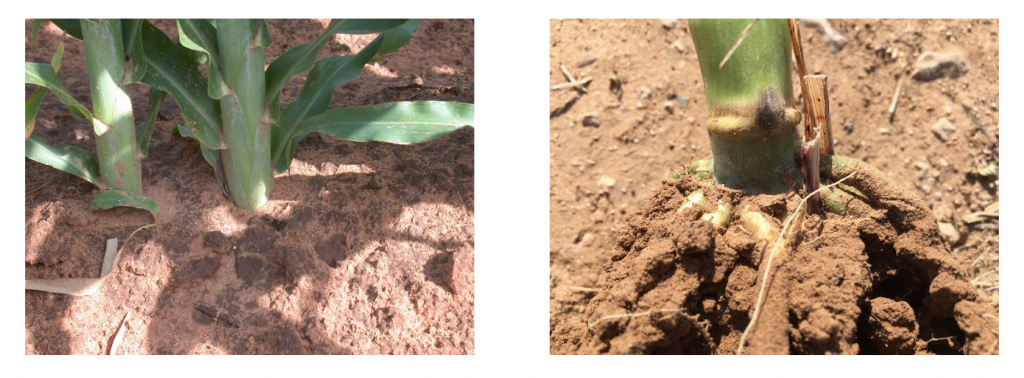
Figs. 1A&B. Soil cultivated around the base of sorghum plants buries brace roots (A); example of large brace roots that developed in the soil of an individual plant (B).
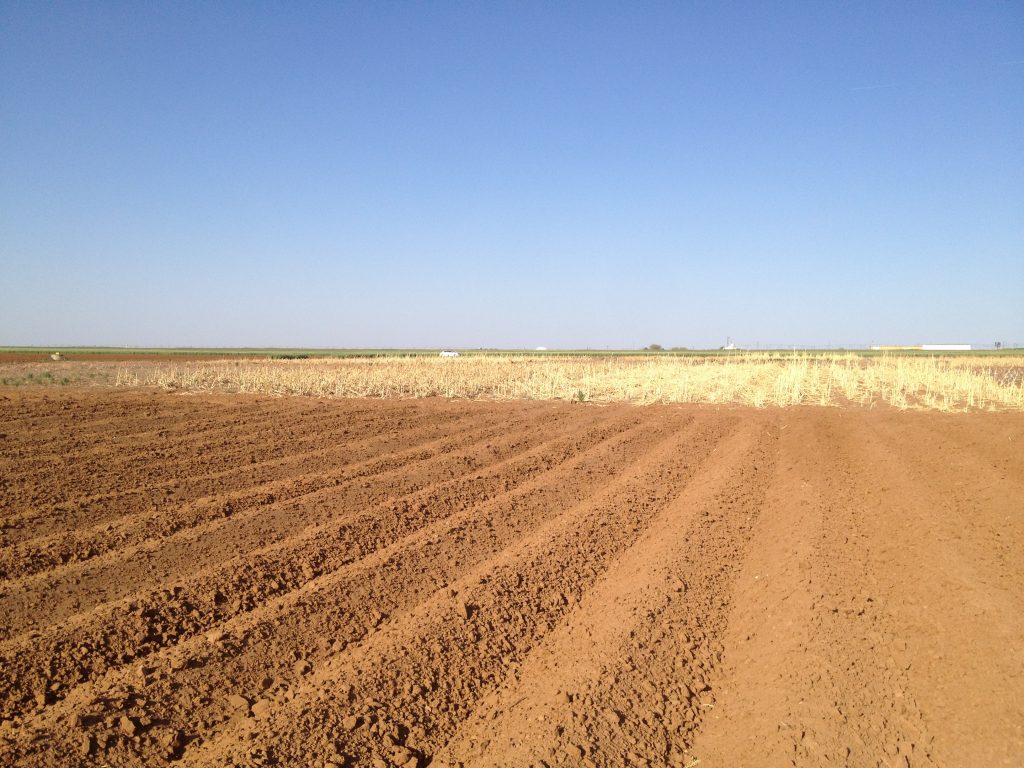
Fig. 2. In semi-arid regions of the U.S. sorghum belt sorghum and other crops are often planted and grown in an elevated position, which may curtail normal sorghum brace root anchorage.
When sorghum is planted and grown in this elevated position (Figs. 3A&B) and brace roots emerge, these roots are compromised as the brace roots:
- Encounter soil that is both warmer and drier, and individual brace root penetration is not assured (Fig. 4, Figs. 5A&B). This condition limits brace roots’ ability to penetrate the soil—roots will not move into or through dry soil (whereas soil in a furrow is cooler and more moist).
- If cultivation is attempted, it is more difficult to cultivate soil to the elevated base of the sorghum plants, because soil must be moved upward and remain there.
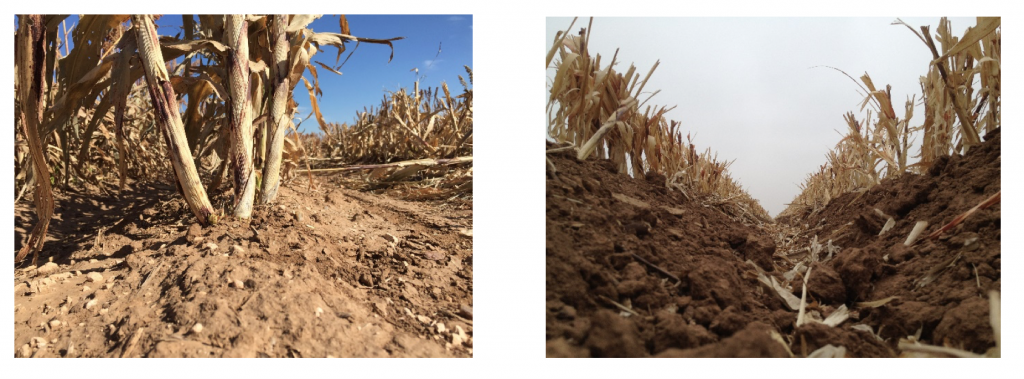
Figs. 3A&B. View of bed-planted sorghum postharvest (A) and furrow view after beds are reformed (B) demonstrating the elevated position (top of the bed) that sorghum and other crops like cotton are planted in to prevent bare soil wind erosion. In this field, surface residues after harvest have been retained (Fig. 3B, in contrast to Fig. 2) as the field has been relisted for the next crop.
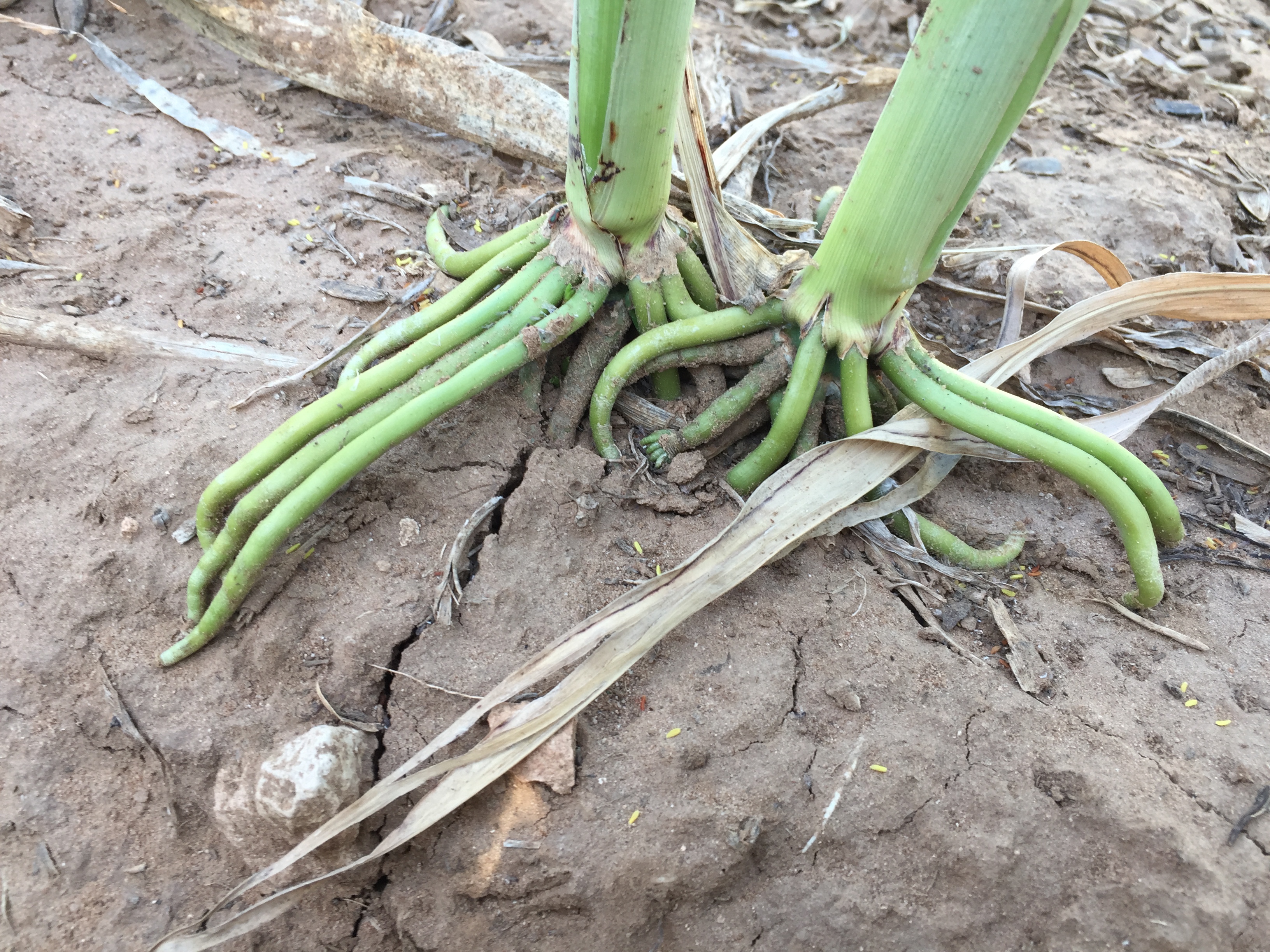
Fig. 4. Brace root elongation in sorghum on top of a listed ridge where due to drier, warmer soil, some brace roots (left) have extended elongation, not yet able to penetrate the soil.

Figs. 5A&B. Individual sorghum brace roots unable to penetrate soil due to soil compaction, hot and dry conditions that are drying and warming surface soil, or possible herbicide carryover.
Grain Sorghum Maturity – Impact on Yield?
This tip was provided by:
Ronnie Schnell, Cropping Systems – Statewide, College Station, ronschnell@tamu.edu
Statewide
Grain Sorghum Maturity – Impact on Yield?
Grain sorghum performance trials conducted by the Soil and Crop Science Department across Texas routinely measure plant characteristics, including days to bloom, plant height, panicle exertion, etc. These characteristics combined with yield data can be useful information when selecting hybrids for your farm.
The number of days from planting to mid-bloom is recorded for every plot each year in the statewide sorghum performance trials (about 1,600 plots per year). Companies designate maturity of hybrids that are entered in the trials and we do see variation in the days to flowering by region. The table below represents data from 12 sites over the last four years, or 48 site-years. Days to flowering tend to be longer in the Blacklands region of Texas and shorter in the High Plains of Texas (Table 1). Planting dates, which can affect temperature (heat unit accumulation) and photoperiod will influence days to flowering. However, maturity designations from companies do correlate with days to flowering ranging from an average of 59 days for early hybrids and 74 days for late hybrids.

Figure 1. Days to flower is defined as the days from planting to when 50% of plants are at mid-bloom.
Do hybrid maturities correlate with grain yield? I general yes, later maturities do produce greater yields on average. However, later maturities do not consistently produce greater yield across all production systems and environments. For irrigated sites, later maturing hybrids tend to produce greater yield in most environments. For sorghum performance trials (http://varietytesting.tamu.edu/grainsorghum/), this includes locations in the High Plains, South Texas Plains and Brazos Valley. For dryland locations in the Blacklands and Gulf Coast regions of Texas, medium to medium-late hybrids tend to produce greater yields on average. For dryland production in other regions of Texas, including the High Plains, earlier maturing hybrids would be preferred due to greater likelihood of soil moisture limitations. In Texas High Plains dryland, though medium-long and long maturity hybrids sometimes produce higher yields in years with good rainfall, there is a risk of drought and these hybrids producing lower grain yield. (AgriLife recommendations for High Plains dryland generally do not recommend maturity longer than medium.)
Agricultural Trends toward Standard Deep Soil Sampling for Soil Testing
This tip was provided by:
Calvin Trostle, Extension Agronomy, Lubbock, 806-746-6101, ctrostle@ag.tamu.edu
Statewide
Agricultural Trends toward Standard Deep Soil Sampling for Soil Testing
In the Jan. 20, 2017 Sorghum Tip I discussed “Still ‘Free’ Nitrogen for Grain Sorghum Production: Revisiting Soil Profile N.” There I noted the merits of deeper soil sampling below 6” in particular to assess subsoil nitrate-N. In a Texas A&M AgriLife soil test this subsoil nitrate-N is fully credited 100% to crop nitrogen requirements (and research shows it should be). This involves soil sampling down to 24”, which is difficult to do on many Texas soils (so sample as deep as you can, down to 24”). Nevertheless, there is increasing recognition of the value of subsoil nitrate for crops. You can review the January report at http://texassorghum.org/still-free-nitrogen-for-grain-sorghum-production-revisiting-soil-profile-n.html
Dr. Ron Schnell and I were both attended the American Society of Agronomy/Soil Science Society of America national meetings in Tampa, FL earlier this week. I noticed increased discussion in several presentations about better fitting the amount of fertilizer additions to projected crop requirements. This was noted on corn, wheat, and cotton, but the same principles apply to grain sorghum. One component of this was the use of deeper soil sampling for N, which when credited to crop nutrient requirement will reduce fertilizer N costs.
Furthermore, though there is currently no decision about changing soil test procedures in Texas within our Texas A&M Soil Testing lab, several major agricultural states including Kansas and North Dakota have moved their standard soil sampling procedures to 24”, or as deep as you can get below the traditional 6” soil sample (maximum 24”). North Dakota State Univ. takes this even further for deep rooted crops like sunflower, especially for fields that have not been in sunflower before; they recommend a second soil sample of 24-48”. This second sample, like in Texas with the Profile Soil Sample Information Form (http://soiltesting.tamu.edu/files/profilesoil.pdf) which Dr. Schnell also discussed in relation to soil sampling on fields affected by Hurricane Harvey in his Sept. 29 Sorghum Tip) is analyzed for nitrate-N only.
The bottom line is as we strive for efficiency in input costs, including nitrogen on grain sorghum—or any crop you grow in Texas—subsoil nitrate-N is an asset to be factored into your cropping decisions. It should represent a net cost savings to most producers.
Do you have your soil tests run at a lab far from where you farm?
There are many soil test labs that producers can choose from. If your fertilizer dealer collects your samples, you may not even know who tests your soil. Ask. If you have your soils tested far from home, including out of state, here are some considerations I encourage you to ask the soil lab:
- Is the method of soil testing extraction procedure appropriate for my soil?—In Texas the Mehlich III test is used to remove nutrients from your soil sample. This method is a compromise between different tests that would be used for acidic soils (east Texas) vs. alkaline soils (Blacklands, High Plains, much of South Texas).
- What do you base your soil recommendations on?—A lab in Nebraska, Illinois, or Kansas may use a different algorithm to determine what recommendation you receive. I can’t assure you that the basis for their recommendations is appropriate for your soil or crop. Would you be concerned getting soil test recommendations for your cotton crop from a lab in Nebraska where cotton is not grown? In another state they may have a different yield response curve for nitrogen in sorghum and other crops, one that is not a good fit for your Texas farm. Texas A&M AgriLife soil test recommendations are derived from tests over 40+ years for a particular crop in Texas soils.
- If you have a fertilizer dealer or consultant that tests your soils for you and makes recommendations, A) ask for a copy of all soil test reports—you are entitled to them, B) inquire about the basis for the recommendations for fertilizer addition.
Sugarcane Aphid Online Webinar Presentations for South & Central Texas
This tip was provided by:
Calvin Trostle, Extension Agronomy, Lubbock, 806-746-6101, ctrostle@ag.tamu.edu
South & Central
Sugarcane Aphid Online Webinar Presentations for South & Central Texas
On September 26, Dr. Robert Bowling, AgriLife Extension entomologist, and Dr. Mike Brewer, AgriLife Research entomologist, both located at Corpus Christi, led a series of online webinars to update producers and industry on sugarcane aphid management. The webinars are posted at https://ccag.tamu.edu/south-texas-sugarcane-aphid-management-conferencewebinar/ You can watch any of the nine presentations at your leisure based on your need. The total amount of programing is about 3 hours. Updates are provided from this season’s insect observations, control strategies, etc.
Additional information on sugarcane aphid hybrid tolerance will be coming soon from extensive hybrid trials both in South & Central Texas as well as the High Plains. I am pleased to report there appears to be many hybrids now that do indeed exhibit significant tolerance to SCA. Foliage remains green, even if there is heavy SCA with honeydew, and heads generally fill adequately even if not sprayed in some cases.
Current Texas High Plains SCA Situation
Most reports I received through last week note that SCA is in great decline or now even gone from many fields. I last found any significant numbers of SCA (some leaves still over 1,000 aphids per leaf) in our Lubbock AgriLife hybrid trial on Monday, Oct. 3—all I had to do to find them was look for the lady beetles (see figure below). By Friday when I rechecked the same spots, the SCA were essentially gone.
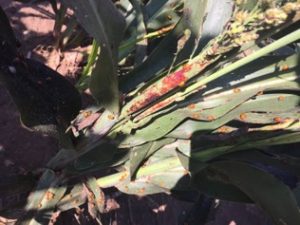
Fig. 1. High lady beetle population cleaning up remaining late-season sugarcane aphids in grain sorghum on October 3, 2017. All SCA were gone by October 7. (Lubbock, TX)
AgriLife Extension entomologists note that producers still need to track potential SCA numbers in their fields until they receive a freeze. If you still have SCA issues but are needing to harvest, the use of either Roundup or sodium chlorate can be applied to dry the crop, but limited research suggests these treatments drive SCA into the head, and that may be worse. A producer might include malathion at a low rate to exert partial control on late-season SCA in the head, but keep the post-harvest interval short. If you still have SCA but want to apply a harvest aid, consult with Extension entomologist Dr. Ed Bynum, Amarillo, (806) 677-5600, ebynum@ag.tamu.edu
Hurricane Harvey – Considerations for Sorghum Fields Next Year
This tip was provided by:
Ronnie Schnell, Cropping Systems – Statewide, College Station, ronschnell@tamu.edu
Tony Provin, State Soil Chemist and Director – Soil Testing laboratory, College Station, t-provin@tamu.edu
South and Central Texas
Hurricane Harvey – Considerations for Sorghum Fields Next Year
Many areas along the Texas Gulf coast were affected by devastating flooding and excessive rainfall during hurricane Harvey. Fields, especially near creeks and rivers, likely experienced significant flooding which may have resulted in soil erosion, soil deposition, residue accumulation and extended periods of saturation. On the brighter side, excellent grain sorghum yields were observed in many areas of south and central Texas. In AgriLife sorghum trials, 9 of 14 sites had hybrids yield greater than 7,000 lb/acre, many over 8,000 pounds. Good grain yield results in greater nutrient removal. These conditions will require some planning and management to ensure successful crops during 2018.
Soil Fertility
- Surface runoff, leaching and gaseous loss of N were likely. The amount and distribution of residual soil N is uncertain.
- A gradual decline in Texas soil sulfur levels have been observed over the past ten years. The large recent leaching and runoff events likely removed most plant available sulfur potentially resulting in the need to apply modest amount of plant available sulfur for the next cropping season.
- Erosion or deposition of soil can result in variation of soil phosphorus levels, as well as other nutrients.
- Sorghum removes about 80 – 40 – 25 lb/acre (N-P2O5-K2O) for every 5,600 lbs of grain. That is equal to 50 lb/acre P2O5 and 31 lb/acre K2O for 7,000 lb/acre grain.
- With all of the uncertainty surrounding current fertility conditions, as they say “don’t guess soil test”.
o Submittal Form: http://soiltesting.tamu.edu/files/soilwebform.pdf
o Profile Sample Form: http://soiltesting.tamu.edu/files/profilesoil.pdf
Weed Control
- Soil deposition and flood waters may have brought unwanted weed seeds to your field, including herbicide resistant weeds. A robust herbicide program should include pre- and post-emergence soil applied herbicides with scouting to apply other post emerge herbicides as needed.
Other Issues
- Soil Compaction – harvesting on wet soils, flooding and saturation all could contribute to compaction issues. Strategic tillage of dry soils can be employed to alleviate compaction. Take note of compaction issues as you soil sample. A shovel or soil probe shouldn’t have to be hammered into the soil.
- Residue Accumulation – normal residue levels will decompose as usual. Excessive accumulation of residue will require dispersal, reduction of particle size and incorporation to aid decomposition. Pay particular attention to soil/mud entrained residue accumulations. Due to limited aeration, muddy residues decompose at a very slow rate compared to normal.
For Texas High Plains, Headworms are Here, Complicating Sugarcane Aphid Control
This tip was provided by:
Calvin Trostle, Extension Agronomy, Lubbock, 806-746-6101, ctrostle@ag.tamu.edu
High Plains
For Texas High Plains, Headworms are Here, Complicating Sugarcane Aphid Control
As much as I would like to talk about something else in this Sorghum Tip, last week I cautioned High Plains growers to guard against complacency regarding sugarcane aphid. If you are a sorghum grower downstate, bear with us we try to reduce the possibility of train wreck in some High Plains fields. Any field that I have looked at that was treated with either Transform or Sivanto has had excellent control (to my knowledge almost all were by ground rig). I have noticed, however, a higher than normal number of winged SCA in several fields. These have to be watched as they can lead to colonies. Furthermore, SCA counts in our AgriLife Lubbock Center SCA tolerance test was completed on Sept. 2, but I was back in the field on Sept. 6 and there was a 10-fold increase in the amount of honeydew in just five days.
So keep scouting sugarcane aphid in the High Plains… especially as AgriLife Extension entomologists are reporting significant numbers of headworms in some fields. You may have fields where they were active down in the whorl; when those leaves unfurled they were a mess. But as long as worms don’t feed deeply in the whorl and damage the developing head, this is only cosmetic. Now the headworm complex is moving into the head and in numbers and worm size that is above threshold. This is a combination of sorghum headworm (cotton bollworm on cotton, or corn earworm on corn) and fall army worm.
If these worms are present at or above threshold in your field it will potentially complicate SCA control. This is because you may have to go to a pyrethroid and/or Lorsban to get control. And though this can also reduce SCA, you are likely eliminating your beneficial insects that fight SCA (adult lady beetles and lady beetle larvae; green lacewings; and syrphid flies, which I learned this week some locals call hover flies, or even ‘hoover flies). This could make SCA even worse.
For further information on control of SCA as well as headworms (and also sorghum midge, if present) read about the control strategies in the Aug. 26 & Sept. 1 newsletters from Texas A&M AgriLife entomology’s “Focus on Entomology” newsletter at http://focusonagriculture.blogspot.com/
Two further thoughts: 1) Some growers are report receiving advice to include Lorsban in their SCA sprays of Sivanto or Transform—DON’T DO IT! You could make things worse; 2) I watched an airplane sprayer treat SCA in southwest Hale County Wednesday: I cringed to see the drift, the inability to cover the ends of the field due to power lines, etc. There is just no way the farmer will get uniform SCA control. What I saw would increase my resolve to use a ground rig with high carrier volume to spray every possible acre that needs treatment. If you are now faced with spraying for SCA if you can cover even some of your acres with a ground rig, I encourage you to do so.
Abundant, even Excessive Rains, in the Texas High Plains—Implications
This tip was provided by:
Calvin Trostle, Extension Agronomy, Lubbock, 806-746-6101, ctrostle@ag.tamu.edu
High Plains
Abundant, even Excessive Rains, in the Texas High Plains—Implications
1. Are your weeds boing berserk?
The latest sorghum is moving toward boot stage though cooler, cloudy weather may have slowed it down. Pigweed has become a problem in some fields. Every weed control herbicide you put out earlier is giving reduced or even little control due to rain after rain in some areas. You may have pigweed that is already 6” or even 12” tall. Options for late season weed control could include Huskie (up to 30” tall grain sorghum, but before flag leaf emergence) or Peak (up to 30” tall, but prior to heading). There really aren’t any tank mix options. Fortunately for some growers the canopy is thick so that may suppress some weeds. I have only given a few details on these two chemicals, so ensure you read the label. There might be another rescue option or two, but I am not sure what that would be.
2. Some grain sorghum is showing pale green to light yellow color on younger leaves coming out of the whorl (Fig. 1).
Due to all the rain, any N applications you made may have been diluted and move downward such that you are now insufficient in nitrogen. Given time, N will move to these younger leaves and they will green. This is not to be confused with the yellow striping between the leaf veins, which is iron deficiency. Lack of iron (Fe) can occur in waterlogged conditions, but I have not seen this yet in the current High Plains grain sorghum crop.
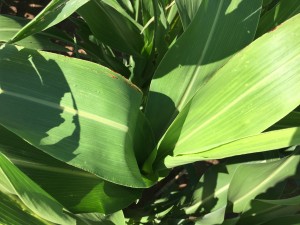
Fig. 1. Light yellowing of most recent leaves may indicate temporary nitrogen deficiency due to leaching of nitrogen in the soil.
By the time sorghum heads out about 70% of N that the plant will require (if it is available) will already be in the plant. Some producers have asked about foliar feeding, but that is only a viable consideration when you can readily deliver a few pounds of N to the crop and absorb the much higher cost per unit of N that foliar feeds represent. For an acute deficiency, a producer looks for a way to deliver a larger amount of N, but we are so late in the season with most sorghum that we don’t normally recommend larger N applications now. Applying a small amount of N now might help, but for the plants represented in Fig. 1, I would say ‘do not apply.’ If you are spraying for sugarcane aphid and your crop is pale, then inquire if a few pounds of N in a product that will be compatible with Sivanto or Transform.
3. Sugarcane aphid in the High Plains is a concern (I hope this is not a surprise)
SCA is now surely present in all counties even if it hasn’t been reported. Infestation levels range from thousands per leaf (most likely the central and lower South Plains and to the east) to first observations the past 10 days (northwest South Plains, Texas Panhandle, eastern New Mexico). With all the rains we have had, based on previous years observations, we might have expected this to set sugarcane aphid back. It didn’t happen. SCA were reaching economically damaging levels shortly after some of the recent rains. Also, producer here have heard how much less SCA was downstate, but at Dr. Pat Porter, AgriLife Extension entomologist, Lubbock, noted, the entomology group believes that the High Plains are different conditions than downstate. Finally, some of our IPM agent newsletters have mentioned that there have been, at least up to about two weeks ago, few beneficial insects present.
Bottom line for SCA, Texas High Plains, 2017: Do not be complacent. You must scout your fields. Tolerant sorghum hybrids may help, but they are not immune, and are all susceptible to SCA at some level. The fact that we have all heard that SCA was less a problem downstate means nothing. The farmer that has a field in Lubbock Co. that recently averaged well over 1,000 aphids per leaf learned this the hard way. I am pleased to report that several of my own SCA sprays (Sivanto, 5 oz./A, 12 gallons/A with my backpack sprayer), show no re-infestation of SCA almost 3 weeks later. Also, if you are only after SCA, do not add Lorsban to your spray (some growers report receiving this advice from applicators). Lorsban, though inexpensive, is not needed for aphids, but only kills your beneficials, and you in fact may be worse off.
Grain Sorghum Harvest Aids and SCA
This tip was provided by:
Ronnie Schnell, Cropping Systems – Statewide, College Station, ronschnell@tamu.edu
Statewide
Grain Sorghum Harvest Aids and SCA
A common question in recent years is whether or not to use a harvest aid, such as glyphosate, if sugarcane aphids are present. Do not use a harvest aid or desiccant as a tool to manage sugarcane aphids. It is uncertain how the aphid will respond following desiccation of the plant. Aphids could move toward the head and create harvest problems. If aphids are at or approaching threshold and could become problematic at harvest, consider an insecticide application. If you need or typically use a harvest aid, follow standard protocol for harvest aid use in sorghum. Keep in mind that pre-harvest intervals differ between insecticides (14 days for Sivanto and Transform) and harvest aids (7 days for glyphosate).
Desiccating leaf and stem tissue and stopping growth of immature grain heads can result in uniform grain moisture and more favorable harvest conditions for grain sorghum. Sodium chlorate and glyphosate are commonly used products labeled for pre-harvest or harvest aid use in grain sorghum. The primary physiological criteria for application include seed moisture below 30%. Sorghum hybrids reach physiological maturity near 30% moisture, which is best determined by identifying black layer in the seed (Figure 1). Remember that kernels near the base of the head mature last. Seed moisture content can differ as much as 6% from the top of the head to the bottom. Also, tiller heads will likely mature later than primary heads and may contribute significantly to yield. Applying products to soon can reduce grain yield and quality. A summary of grain sorghum harvest aids and their uses can be found at: http://publications.tamu.edu/CORN_SORGHUM/PUB_Harvest%20Aids%20in%20Sorghum.pdf
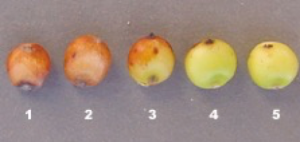
Figure 1. Sorghum kernels in various stages of maturity harvested from the same head from the most mature (1) to the least mature (5). The black layer is first readily visible in (3) and becomes more distinguishable as the seed loses moisture. Do not confuse black layer, which develops where the seed is attached to the plant (bottom end when in the head), with the black dot on the opposite end of the seed.



